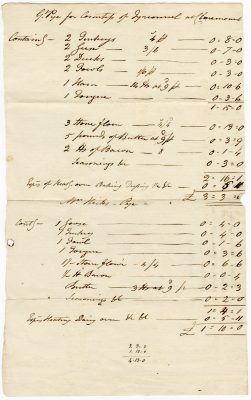The Ingredients for Making a Great Pie for the Countess of Tyrconnel at Claremont, Circa 1783-1800
Reference: 2DE 30/15/1
Suggested age groups: KS2, KS3, KS4, Lifelong Learners
Subject areas: 18th Century Food & Cookery
CONTEXT
The Delaval family lived at Seaton Delaval in south east Northumberland but also had estates in the late 18th century at Ford (North Northumberland) and Doddington (Lincolnshire). At this time the 1st Baron Delaval, John Hussey Delaval was living at Seaton Delaval Hall. He was involved in politics and for various periods between 1754 and 1786, he was an MP for Berwick. The family were renowned for their parties and lavish entertaining at Seaton Delaval Hall.
The Countess of Tyrconnel was Sarah Hussey Delaval (1763 –1800), the youngest daughter of John Hussey Delaval and his second wife Susanna. She married George Carpenter, 2nd Earl of Tyrconnel in 1780. Claremont House, near Esher in Surrey was their summer home.
This document lists the costs for creating two pies, one for the Countess of Tyrconnel which was to be sent to her at Claremount, and the second for Mrs Elizabeth Hicks, the mistress of Baron Delaval.
The “Great Pie” must have been huge and how was it transported from Seaton Delaval to Surrey? It would have had a pastry base and top but what size must it have been if it held – 2 turkeys; 2 geese; 2 ducks; 2 fowls; 1 ham and 1 tongue? The pastry alone was made from 42lbs (19kg) of flour and 5lbs (2kg) of butter. The total cost of making it was £3 3s 0d (equivalent to £241.80 in 2017).
The second pie, for Mrs Hicks, only contained 1 goose, 1 turkey, 1 fowl and 1 tongue. It only cost £1 10s 0d (equivalent to £115.14 in 2017) to make.
ACTIVITIES
ACTIVITY 1
Background
This document lists the costs for creating two pies, one for the Countess of Tyrconnel which was to be sent to her at Claremount, and the second for Mrs Elizabeth Hicks, the mistress of Baron Delaval.
SEE
See: Where was the great pie made?
See: Who was each pie made for?
See: Where was the pie sent to?
See: What ingredients were used to make the pie?
See: How much did each pie cost? What is this equivalent to today?
THINK
Think: Are these ingredients similar to what you would put in a pie?
Think: How do you think the pie was cooked?
Think: How do you think the pie was transported to Claremont House?
Think: How long do you think it took the pie to be transported?
Think: Do you think the pie was expensive? How much do you think it would cost to make a similar pie today?
Think: Why do you think the pies were made?
DO
Do: Try reading the document. Can you pick out some of the ingredients in the pie?
Do: Read the document out loud. Does this make it easier to understand?
Do: Look on a map. Can you find Seaton Delaval Hall and Claremont House? Plot the route you think the pie may have taken to get there.
Do: Can you convert the ingredient quantities to create a recipe for the pie that could be made in the home today?
Do: How much would it cost to make the great pie today? Research how much each of the ingredients costs in the specified quantity today. Create a table to compare the costs.
Do: How elaborate do you think the pie looked? Try drawing, designing or making a model of your own elaborate pie.
Do: Come up with your own idea for a great pie. This could be sweet or savoury. Think about what size it will be.
Do: Create an annotated sketch of your pie.
Do: Write a recipe for your great pie.
Do: Create a costing document for your pie. Think about hidden costs such as gas or electric to run the oven.
Do: Make your pie.
Resources
OTHER ONLINE RESOURCES
Delaval Pedigree – https://northumberlandarchives.com/learn/hg/learn-topic-hannah-glasse/delaval-pedigree/
National Archives currency converter – https://www.nationalarchives.gov.uk/currency-converter
Seaton Delaval Hall – https://www.nationaltrust.org.uk/seaton-delaval-hall



